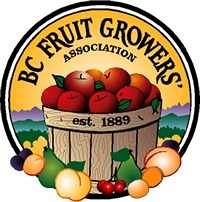Codling Moth
General Description
Hosts
Apple, crabapple and pear; rarely other fruit trees in B.C.
Damage
Surface ‘stings’ (Fig. 1) or holes in fruit plugged with dark masses of excreta (Fig.2); both types of damage allow fungi and bacteria to enter the fruit and cause fruit rot during storage (Fig. 3).
.jpg) |
.jpg) |
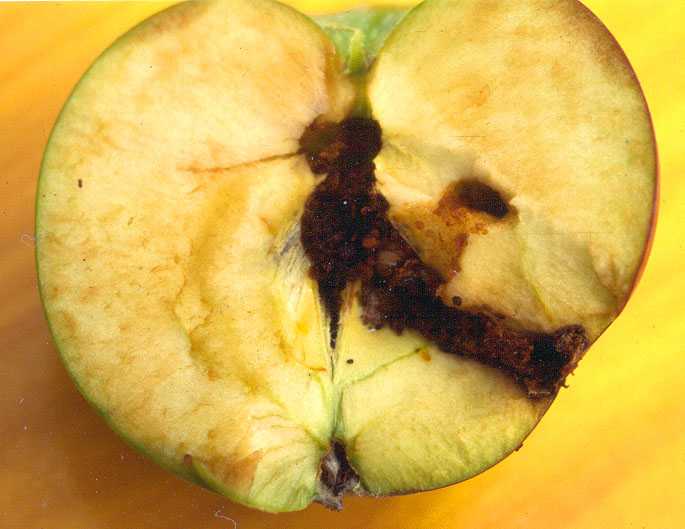 |
| Figure 1. Codling moth larval entries (stings). (H. Philip) | Figure 2. Pears showing larval excreta. (BCMA) |
Figure 3. Larval feeding damage. (BCMA) |
Identification
Larva - Pinkish-white caterpillar with black or mottled black head; mature larvae 12-20 mm long (Fig. 4).
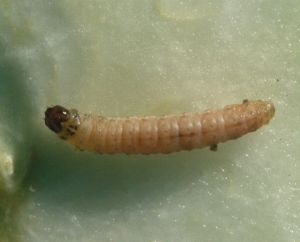 |
| Figure 4. Codling moth larva (BCMA) |
Adult - Brownish-gray moth about 10-12 mm long with a copper spot on the end of each forewing (Fig. 5).
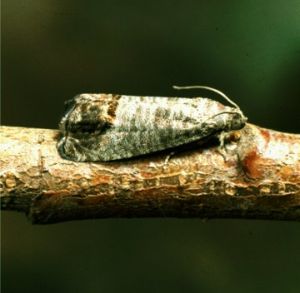 |
| Figure 5. Adult codling moth. (AA-FC) |
Life History
Mature codling moth larvae overwinter in silken cocoons in protected sites on the tree (under loose bark, in cracks and crevices), in the soil or in wooden materials under or beside infested trees (bins, ladders, poles, buildings, large prunings). Larvae pupate in the spring and adults usually begin to emerge in early May and continue emerging until late June (mid-July in cooler areas), depending on temperature. Mating and egg-laying occur when twilight temperatures are above15°C. Females lay eggs on fruit or on leaves near fruit. Larvae usually wander over the fruit surface before cutting through the skin and boring deeply into the fruit. Mature larvae leave the fruit to pupate in protected sites on and off the tree as described above. Second generation moths appear in late July and August. Because weather during July and August is usually favourable for codling moth activity and reproduction, second-generation larvae can cause considerable damage, often close to harvest. If weather is warm during late August or early September a partial third generation may occur in southern districts.
Monitoring
The OKSIR Program places pheromone-baited traps in every pome fruit orchard (1/ha) in the program area (Fig. 6). Capture data for every trap is posted within 24 hours of collection on the OKSIR web site under Trap Data/Orchard Trap Database (http://www.oksir.org/traps.asp).
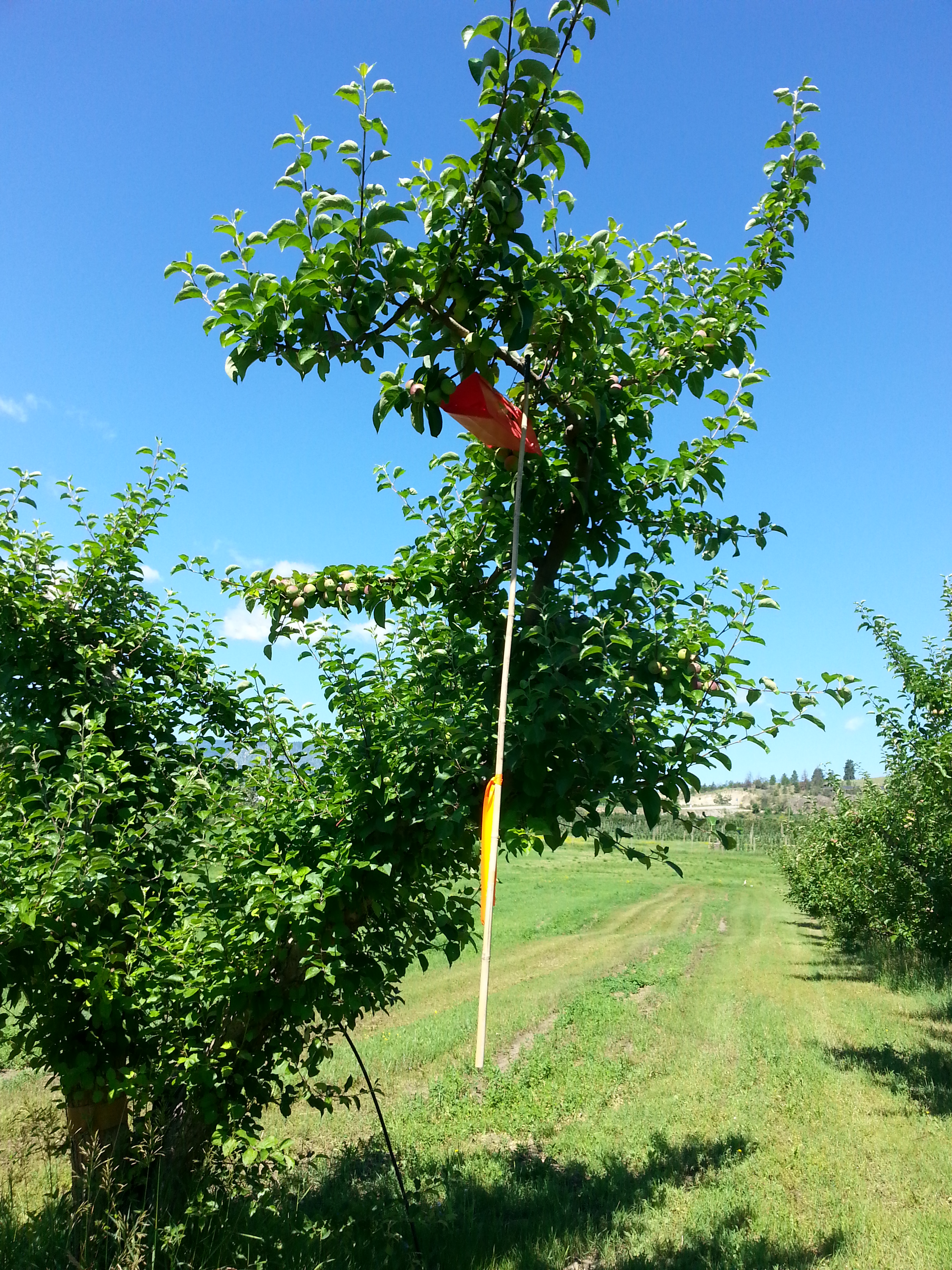 |
| Figure 6. OKSIR Program pheromone trap. (OKSIR) |
The Program also releases sterile codling moths weekly in the same orchards from May to September (see IFP & Organics chapter). Sterile male moths are also attracted to the pheromone traps. To distinguish sterile from wild male moths, crush each captured moth and those that do not leave a pink to red stain are wild moths.
For growers wishing to place more traps in their orchard, obtain a copy of factsheet Codling Moth Sex Pheromone Traps from the BCMA Kelowna office which provides details on installation, placement, maintenance and use of traps, and assists in the interpretation of trap captures. Install the traps in orchards by the pink bud stage and check weekly to record the location and the number of wild male moths captured.
Replace the lures every 4 weeks and change the trap bottoms when the stickiness diminishes.
Each trap will monitor approximately 1 hectare of orchard. Orchards less than 1 hectare or with mixed fruit types or very irregular borders are difficult to monitor with pheromone traps. After a spray is applied, service the traps as usual to provide the information needed for decisions on additional sprays. Continue to monitor trap catches until 2 weeks before harvest.
Timing of the first codling moth spray in the spring can be more accurate if the beginning of egg hatch is predicted using codling moth trap captures and degree-day accumulations. The BCMA (Kelowna) factsheet Predicting Codling Moth Spray Dates with Degree-Days explains how to measure temperatures, determine biofix and calculate degree-days necessary to time the first spray. A maximum-minimum thermometer housed in a well-ventilated shelter is required in order to record minimum and maximum temperatures necessary to calculate degree-days.
Management
Biological Control
Virosoft CP4 Granulovirus – Codling moth larvae must eat the virus before they enter the fruit, so thorough coverage is essential. The efficacy of the virus deteriorates quickly (short residual period). Apply weekly in the late afternoon or on a cloudy day throughout the period when codling moth larvae are emerging from eggs. Because the granulovirus does not kill codling moth larvae as quickly as most chemical sprays, some feeding damage will occur. Store Virosoft in a cool place between uses to reduce degradation of the granulovirus. This product is certified for use in organic production orchards.
Cultural Control
Banding - Cardboard banding works by trapping and removing larvae after they have left the damaged fruit but before they emerge as adults for the next generation. Wrap corrugated cardboard bands around tree trunks and scaffold limbs by mid-June through to the end of July (apply by 555 DD). Any larvae that would otherwise be spinning their cocoons on the trunk or scaffold branches will be captured in the bands. Remove and replace the bands applied for the first generation larvae around mid-July (750 DD) and burn immediately to prevent larvae from completing their development. If applying bands for the second generation, remove and destroy the replacement bands after harvest. In warm years with a 3rd generation, remove the summer bands at regular intervals to prevent development or remove bands at 1350 DD. Banding material is available from chemical suppliers or OKSIR program.
Fruit Removal - It is extremely important that fruit found infested with codling moth is not left on the trees at any time during the growing season. Growers should make sure that infested fruit found while thinning and picking is destroyed, in order to kill any larvae in the fruit; complete crushing of fruit is the best way to kill larvae. Culled fruit should never be dumped in orchards. If infested fruit is placed in soapy water to drown the larvae, do not remove the apple for at least one week.
Sanitation – Remove any non-commercial codling moth host trees; if on surrounding properties or public lands, inform SIR staff. Woodpiles and any wooden structures, such as fruit bins or boxes, tree props, or ladders, are important sources of overwintered codling moths. As codling moth populations decrease, it becomes important to eliminate or treat wooden structures within or immediately adjacent to the orchards. Pay attention to the source of anything wooden entering the orchard, especially wooden bins and props.
Mating Disruption- Mating disruption works by preventing male moths from finding female moths for mating within blocks treated with the pheromone dispensers, Isomate-C Plus (codling moth) or Isomate CM Flex (codling moth) or Isomate-CM/LR TT (codling moth and leafrollers twin tubes). This control tactic is most effective when applied on an area-wide basis involving as many adjoining orchards as possible. Isomate-C Plus and Isomate CM Flex should be applied at a rate of 500-1000/ha (200-400/ac), Isomate-CM/LR TT at a rate of 750/ha (300/ac) before the first moths fly in the spring. Do not reduce the rate before consulting with the SIR program or your crop management advisor. Place the dispensers in the upper third of the canopy, preferably in shaded areas. Orchards less than 2 ha in size are not suitable for mating disruption. Growers should apply a border cover spray along edges adjacent to unmanaged sources of codling moth. Place additional dispensers in border trees to minimize the effect of immigration. Carefully read and follow the instructions provided with the dispensers.
Chemical Control
Only apply cover sprays in orchards or parts of orchards with an average capture over 2 consecutive weeks of two or more moths per trap per week over the 2 weeks, weather permitting. By using degree-day predictions to time the first spray, forecasting dates of codling moth egg laying and hatch is more accurate and spraying can occur when the control products can perform most effectively. Information on the approximate time of egg laying and hatch is available from most packinghouse field service offices and on the OKSIR web site (www.OKSIR.org/Degree Days). The OKSIR web site also lists the weekly accumulated degree day totals for 18 weather stations located within the OKSIR Program area. Because the optimum timing varies among the products based on how they control codling moth, first read the product labels to become familiar with the recommended timing.
The following table summarizes application information on control products recommended for codling moth control. Trade (product) names are linked to the Pesticide Label Search database of the Pest Management Regulatory Agency (PMRA). Click on the Registration Number of the product to read the current label. If more than one product name appears on the list, click on the Registration Number of the product of interest.
|
Trade Name |
Common Name |
Target Stages |
Maximum Number of Applications1 |
Spray Interval (days) |
Pre-harvest Interval (days) |
|
chlorantroniliprole |
Larvae |
3 |
10 - 14 |
5 |
|
|
acetamiprid |
Eggs, larvae |
4 |
12 |
7 |
|
|
thiacloprid |
Eggs, larvae |
4 |
14 - 21 |
30 |
|
|
Confirm 240F |
tebufenozide |
Larvae |
4 |
10 - 14 |
14 |
|
fenpropathrin |
1 |
N/A |
23 |
||
|
spinetoram |
Larvae |
3 |
14 |
7 |
|
|
spinosad |
Larvae |
3 |
7 - 10 |
7 |
|
|
cyantraniliprole |
Larvae |
4 |
10 - 14 |
3 |
|
|
cyclaniliprole |
Larvae |
3 |
10 - 14 |
7 |
|
|
Imidan WP |
phosmet |
Larvae |
5 |
10 |
14 |
|
Intrepid 240F |
methoxyfenozide |
Eggs, larvae |
2 |
14-21 |
14 |
|
Minecto Pro |
abamectin + cyantraniliprole |
larvae |
1 |
n/a |
28 |
|
novaluron |
Eggs, larvae |
4 |
10 - 14 |
14 |
|
|
granulovirus |
larvae |
n/a |
14 |
0 |
|
|
sulfoxaflur + spinetoram |
Larvae |
2 |
14 |
7 |
|
|
tetraniliprole |
Eggs, larvae |
3 |
7 |
7 |
1 As per label restrictions. 2 Suppression only
Apply Assail, Calypso, Intrepid, or Rimon during egg-laying starting around 150 degree days if codling moth damage was more than 1% the previous year. NOTE: Rimon is registered for use on apples only. Application rates for Rimon depend on the concentration (0.93 or 1.4 L Rimon/1000 L) of the spray mixture and the spray volume applied to provide thorough coverage (minimum 700 L/ha (283 L/acre)). Consult the product label before mixing Rimon 10 EC for correct spray volume according to tree height. Apply Altacor, Assail, Calypso, Confirm, Entrust, Exirel, Harvanta, Intrepid, Rimon, TwinGuard, or Virosoft after the degree-day total predicts that egg hatch is beginning (about 220-300 degree-days) and trap counts have reached the recommended treatment level. To be most effective, larvae must eat these products so thorough and timely coverage is essential. Apply Delegate once egg hatch is over 90% complete. Do not apply Intrepid after egg hatch is complete.
Apply additional first brood and second brood sprays only after pheromone trap captures reach treatment levels and the residual protection from sprays ends. Under low-rainfall conditions, Calypso provides about 2-3 weeks protection from codling moth damage; Assail, Confirm, Exirel, Imidan, Intrepid, and Rimon provide about 10 to 14 days protection. Larvae must eat Altacor, Assail, Confirm, Delegate, Exirel, Intrepid, and Rimon, to be most effective so thorough and timely coverage is essential.
Research shows that application of neonicotinoid products such as Assail may cause increased mite populations. Therefore do not apply more than two applications of Assail or Calypso either alone or alternately per season regardless of target pest (codling moth, aphids, leafhoppers, leafminers) to avoid mite flare-up. Rimon may also disrupt biological mite control. If Sevin is used as a thinning spray in the same block treated with Assail, and or Calypso, consider monitoring mite levels.
Pesticide resistance management - It is important to alternate application of insecticides from different chemical groups or with different modes of action in order to avoid development of pesticide resistance. All insecticide products have a pesticide Group number displayed on the label.
See the table in Chemical Groups and Pesticide Resistance Management which lists the Group numbers for all pesticides recommended in the Guide to aid in selecting insecticides to avoid pesticide resistance development.
Visit the OKSIR Program web site (www.OKSIR.org) for more information about codling moth control.
